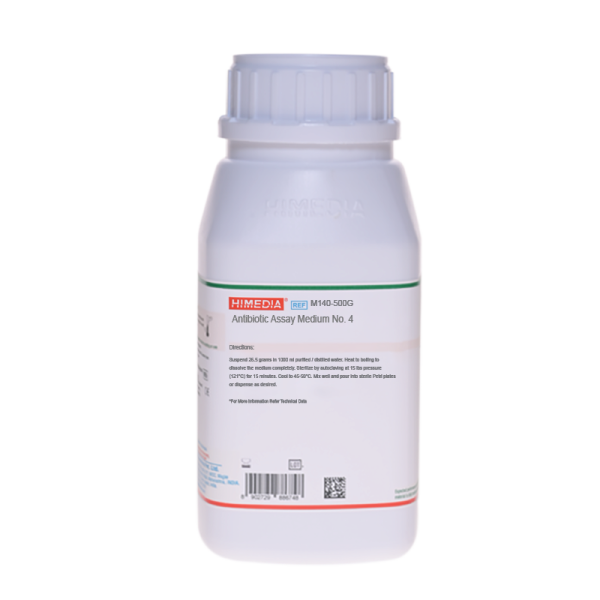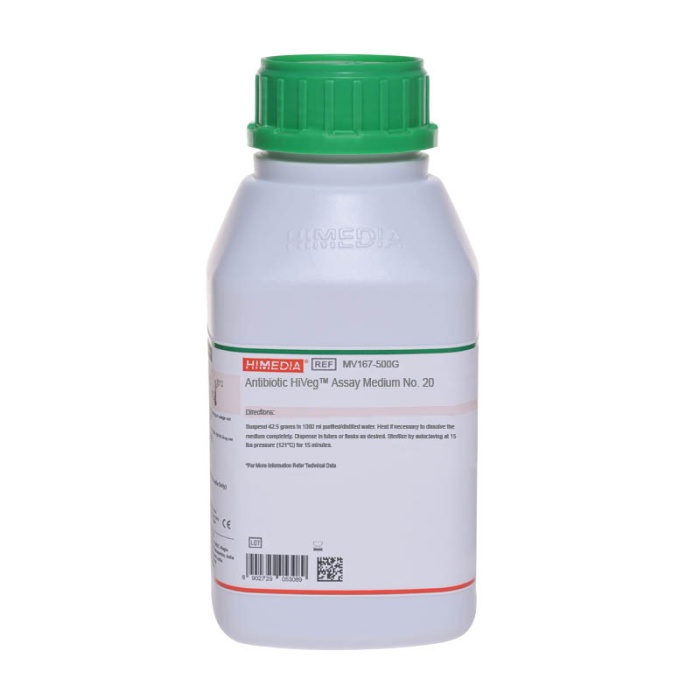 Your enquiry has been submitted
Your enquiry has been submitted
Antibiotic Assay Medium No. 4 (Yeast MB Agar)
penicillin/ Inhibitory Substances in Milk#CC293D
Intended Use
Recommended for detection of Penicillin-G in milk samples using Bacillus stearothermophilus.
Composition**
| Ingredients | Gms/Litre |
|---|---|
| Peptone | 6.000 |
| HM peptone B # | 1.500 |
| Yeast extract | 3.000 |
| Dextrose (Glucose) | 1.000 |
| Agar | 15.000 |
Final pH (at 25°C): 6.6±0.2
**Formula adjusted, standardized to suit performance parameters
# Equivalent to Beef extract
Directions
Suspend 26.5 grams in 1000 ml of purified / distilled water. Heat to boiling to dissolve the medium completely. Sterilize by autoclaving at 15 lbs pressure (121°C) for 15 minutes. Cool to 45-50°C. Mix well and pour into sterile Petri plates.
Principle And Interpretation
Antibiotic Assay Medium No. 4 (Yeast MB Agar) is suitable for plate counts in pharmaceutical and related products and for the microbial assay and detection of antibiotics like penicillin in milk. These medium is formulated in accordance to the specifications and procedures listed by the Food and Drug Administration (2).This medium is identical numerically with name assigned by Grove and Randall (3).
Peptone, yeast and HM peptone B provides nutritional requirement for growth of the indicator organims like Bacillus stearothermophilus, Micrococcus luteus. This medium is similar to Antibiotic assay medium no. 2 except for the additional ingredient dextrose. Dextrose in the medium serves as easily available source of carbon stimulating luxuriant growth of the test organims. Generally presence of penicillin in milk is detected by the cylinder plate method, using Micrococcus luteus as the test organism, and a paper disk method, using Bacillus stearothermophilus. The cylinder plate method is recommended as the standard for quantification of B-lactam residues. A description of the cylinder plate method for detecting penicillin in dry powdered milk is given by Kramer et al. (3). The same basic procedure is also recommended in the assay of penicillin in fluid milk.
Freshly prepared plates should be used for antibiotic assays.The use of this medium assures well defined zones of the test organism. All conditions in the microbiological assay must be controlled carefully. The use of standard culture medium in the test is one of the important step for obtaining good results.
Type of specimen
Dairy samples
Specimen Collection and Handling
For dairy samples follow appropriate techniques for handling specimens as per established guidelines (1,4,7).
After use, contaminated materials must be sterilized by autoclaving before discarding.
Warning and Precautions
Read the label before opening the container. Wear protective gloves/protective clothing/eye protection/ face protection. Follow good microbiological lab practices while handling specimens and culture. Standard precautions as per established guidelines should be followed while handling specimens. Safety guidelines may be referred in individual safety data sheets.
Limitations
- Further biochemical and serological testing is required for complete identification.
Performance and Evaluation
Performance of the medium is expected when used as per the direction on the label within the expiry period when stored at recommended temperature.
Quality Control
Appearance Cream to yellow homogeneous free flowing powder
Gelling Firm,comparable with 1.5% Agar gel
Colour and Clarity of prepared medium Yellow coloured clear to slightly opalescent gel forms in Petri plates
Reaction Reaction of 2.65% w/v aqueous solution at 25°C. pH: 6.6±0.2
pH 6.40-6.80
Cultural Response
Cultural characteristics observed after an incubation at 55°C for 18-24 hours.
| Organism | Inoculum (CFU) | Growth | Recovery |
|---|---|---|---|
| Bacillus stearothermophilus ATCC 7953 | 50-100 | good-luxuriant | >=50% |
| Micrococcus luteus ATCC 10240 | 50-100 | good-luxuriant | >=50% |
Storage and Shelf Life
Store between 10-30°C in a tightly closed container and use freshly prepared medium. Use before expiry date on the label. On opening, product should be properly stored dry, after tightly capping the bottle in order to prevent lump formation due to the hygroscopic nature of the product. Improper storage of the product may lead to lump formation. Store in dry ventilated area protected from extremes of temperature and sources of ignition Seal the container tightly after use.
Product performance is best if used within stated expiry period.
Disposal
User must ensure safe disposal by autoclaving and/or incineration of used or unusable preparations of this product. Follow established laboratory procedures in disposing of infectious materials and material that comes into contact with sample must be decontaminated and disposed of in accordance with current laboratory techniques (3,4).
Reference
- American Public Health Association, Standard Methods for the Examination of Dairy Products, 1978, 14th Ed., Washington D.C.
- Grove and Randall, 1955, Assay Methods of Antibiotics Medical Encyclopedia, Inc. New York.
- Isenberg, H.D. Clinical Microbiology Procedures Handbook 2nd Edition.
- Jorgensen, J.H., Pfaller, M.A., Carroll, K.C., Funke, G., Landry, M.L., Richter, S.S and Warnock., D.W. (2015) Manual of Clinical Microbiology, 11th Edition. Vol. 1.
- Kramer, J., G.G. Carter, B. Arret, J. Wilner, W.W. Wright, and A. Kirshbaum. 1968. Antibiotic residues in milk, dairy products and animal tissues: methods, reports and protocols. Food and Drug Administration, Washington, DC.
- Tests and Methods of Assay of Antibiotics and Antibiotic containing Drugs, FDA, CFR, 1983 Title 21, Part 436, Subpart D, Washington, D.C.: U.S. Government Printing Office, paragraphs 436, 100-436, 106, p. 242-259, (April 1).
- Wehr H. M. and Frank J. H., 2004, Standard Methods for the Microbiological Examination of Dairy Products, 17th Ed., APHA Inc., Washington, D.C.
| Product Name | Antibiotic Assay Medium No. 4 (Yeast MB Agar) |
|---|---|
| SKU | M140 |
| Product Type | Regular |
| Physical Form | Powder |
| Origin | Animal |
| Packaging type | HDPE |
| References | 1.American Public Health Association, Standard Methods for the Examination of Dairy Products, 1978, 14th Ed., Washington D.C. 2.Grove and Randall, 1955, Assay Methods of Antibiotics Medical Encyclopedia, Inc. New York. 3.Isenberg, H.D. Clinical Microbiology Procedures Handbook 2nd Edition. 4.Jorgensen,J.H., Pfaller, M.A., Carroll, K.C., Funke, G., Landry, M.L., Richter, S.S and Warnock., D.W. (2015) Manual of Clinical Microbiology, 11th Edition. Vol. 1. 5.Kramer, J., G.G. Carter, B. Arret, J. Wilner, W.W. Wright, and A. Kirshbaum. 196 |
| Customized Product Available | No |









